#ancient roman coin
Text

#hermes worship#hermes#mercury#hermes god#ancient greek god#greek god#coin#greek myth#greek myth art#ancient greek mythology#greek mythology#ancient greek coin#roman coin#medieval coin
2K notes
·
View notes
Text

View of the Forum Romanum by Salomon Corrodi
#salomon corrodi#art#roman forum#forum romanum#rome#ancient rome#ancient roman coins#roman#antiquity#architecture#city#ancient#europe#european#history#italy#ruins#landscape
629 notes
·
View notes
Text
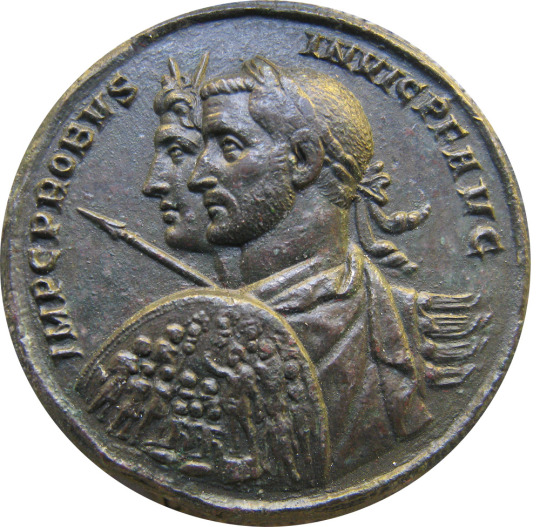
Coin minted ca. 280 CE by the Roman emperor Marcus Aurelius Probus (r. 276-282). Probus is shown in the company of Sol Invictus ("Unconquered Sun"), a late form of the solar deity whose worship had been promoted by Probus' predecessor Aurelian. The birthday of Sol Invictus (Dies Natalis Solis Invicti) was traditionally celebrated on Dec. 25. On this coin, Probus, who was constantly on campaign during his brief reign, is shown prepared for battle with shield and spear, alongside Sol Invictus, who wears his characteristic radiant crown. Now in the National Museum of Denmark, Copenhagen. Photo credit: ChrisO/Wikimedia Commons.
#classics#tagamemnon#Ancient Rome#Roman Empire#ancient history#Roman history#Probus#M. Aurelius Probus#Roman religion#Ancient Roman religion#religio Romana#Sol Invictus#art#art history#ancient art#Roman art#Ancient Roman art#Roman Imperial art#coins#ancient coins#Roman coins#Ancient Roman coins#numismatics#ancient numismatics#Roman numismatics#National Museum of Denmark
306 notes
·
View notes
Text

A Tale of Two Coins - 2000 years apart!
On the right is a Judea Capta coin from 71 AD, 1952 years ago. The coin says “Judea conquered" in latin. These were commemorative coins originally issued by the Roman Emperor Vespasian to commemorate the capture of Judea and the destruction of the Jewish Second Temple by his son Titus in 70 CE during the First Jewish Revolt. On one side of the palm tree is a weeping defeated Jewish woman. On the other a victorious Roman soldier.
On the left, we see the same palm tree representing the Jewish homeland, but instead of a Roman soldier, there is a Jewish woman holding a baby up to the heavens symbolizing the rebirth of the Jewish people like a phoenix out of the ashes. In place of the weeping woman is a Jewish farmer (her husband) planting new roots for the Jewish people in the Jewish homeland. Instead of “Judea Capta'' the words read - “Israel Liberated 1948″.
These two coins sum up the history of exile and return of the indigenous Jews to the Kingdom of Israel.
In the prophetic words of the Bible: “They who sow in tears shall reap in joy.” (Psalm 126)
#secular-jew#israel#jewish#judaism#israeli#jerusalem#diaspora#secular jew#secularjew#islam#coins#ancient coins#judean coinage#judea#samaria#romans#judea capta#vespasian#titus#emperor#roman empire#Israel liberated#1948#hamas#coinage#second temple#1st century#palestine#Palestinian#gaza
367 notes
·
View notes
Text
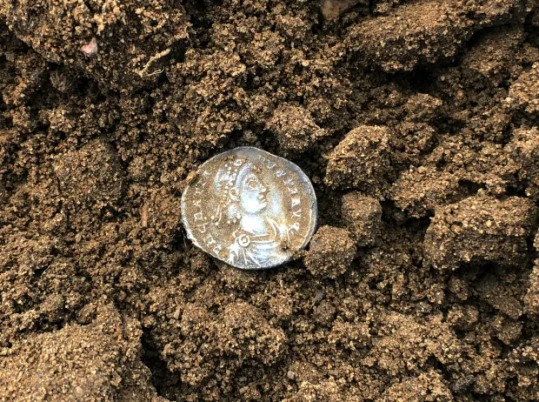
Roman Coin Hoard Found in England Sells at Auction
A hoard of Roman coins discovered by a metal detectorist scouring farmland has fetched more than £15,000 after going under the hammer.
More than 430 coins were found buried in the village of Colkirk, near Fakenham, Norfolk.
A collection of 73 pieces, including an extremely rare coin featuring a phoenix on a globe, was auctioned in London.
The anonymous finder had shown "perseverance", said coin specialist Nigel Mills, from Noonans auctioneers.
"Some of the people I've spoken to recently, who have found some amazing finds, are spending a lot of time detecting - hours and hours - and they don't give up," he said.

"They keep going and that's the secret in so many things - don't give up, keep looking."
The Colkirk hoard, believed to date back to the early 5th Century, was spread out across a third of an acre on arable farmland, although the majority of finds were discovered in a 1.5m (59in) radius.
It was a lucky find for the detectorist, who had no idea the soil held such treasures.
They were out searching a field in January 2020 when they spotted a silver coin, which they recognised as a siliqua - a small, thin Roman coin.
It sparked a haul of 40 coins that day, with a further 40 found on the following one.
Covid lockdowns meant searches became more sporadic, but each discovery was logged with a portable GPS unit to accurately pinpoint the hoard's distribution.
In all, 315 coins were found in 2020, 114 in 2021 and three in 2022.
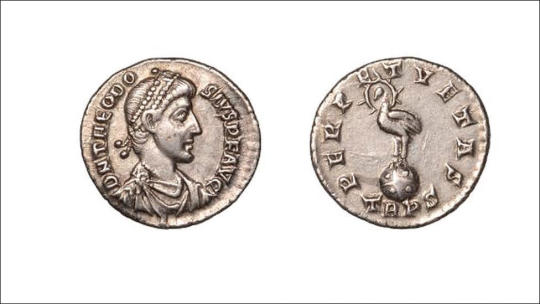
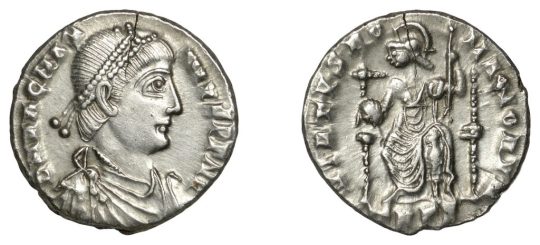
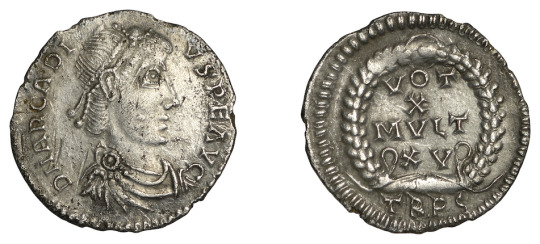
Some of the coins had been damaged, while others were fragmented due to farming processes.
A commemorative Third Miliarensis coin issued by Emperor Theodosius, decorated with a phoenix on one side, was only the fifth one of its type known to exist, with all the others in museums.
It reached £3,400 at the sale in Mayfair.
Mr Mills said: "The hoard had [been] spread out over a third of an acre through disturbance by ploughing and has been recorded under the Treasure Act.
"The hoard is likely to have been deposited at the beginning of the 5th Century AD, with the latest coin of Honorius dating no later than 402 AD.
"Other Roman treasure finds of gold and silver also from East Anglia, such as the Hoxne and Thetford hoards, reflect the wealth and importance of the area."

#Roman Coin Hoard Found in England Sells at Auction#village of Colkirk#metal detecting#coins#collectable coins#roman coins#ancient coins#ancient artifacts#archeology#archeolgst#history#history news#ancient history#ancient culture#ancient civilizations#roman history#roman empire#roman art
195 notes
·
View notes
Text
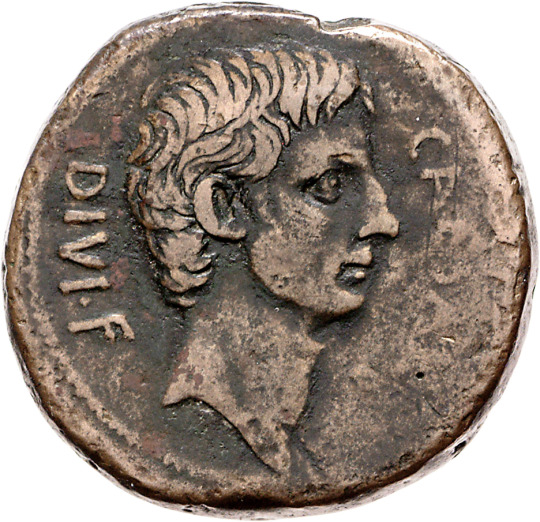
Octavianus
* Italy
* 38 BCE (about)
* silver
* CAESAR - DIVI F
* Berlin state museums, numismatic collection
Source Münzkabinett, Staatliche Museen zu Berlin
Creator: Dirk Sonnenwald
Copyright Notice: Public Domain; CC BY-SA @ Münzkabinett;
87 notes
·
View notes
Text

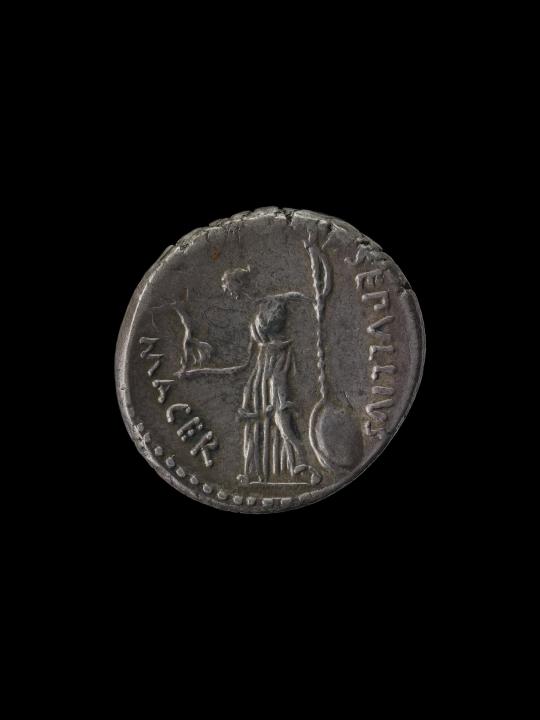
Denarius with head of Julius Caesar (obverse) and Venus holding Victory (reverse), minted under P. Sepullius Macer at Rome
Roman, Republican Period, 44 B.C.
silver
British Museum
#Ides of March#Julius Caesar#Caesar#Ancient Rome#Roman Republic#Republican Period#Rome#denarius#silver#coin#numismatics#Venus#Victory#British Museum
100 notes
·
View notes
Text
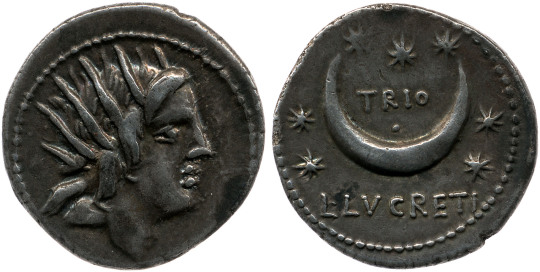
~ Denarius.
Moneyer: L. Lucretius Trio
Cultures/Period: Roman Republican
Date: 76 B.C.
Place of origin: Italy, Rome, Lazio
Medium: Silver
#ancient#ancient art#history#museum#archeology#roman#ancient history#archaeology#sol#denarius#coin#currency#stars#moon#lazio#silver#76 b.c.#lucretius
674 notes
·
View notes
Text

Bronze sestertius of Trajan A.D. 103–111 x
125 notes
·
View notes
Text
Coins of the Deified Augustus, 14-268 CE
The most fascinating thing about these types is how Augustus's portrait changes with the engraving style of the period as his portrait is sort of fused with that of the current emperor.

Divus Augustus Dupondius, struck under Tiberius.
A pretty much unaltered portrait of Augustus, something we won't be seeing often when it comes to these coins. Struck 22-23.

Divus Augustus under Tiberius, laureate head of Tiberius on obverse, laureate head of Augustus on reverse with star above. Struck 14-16.

Divus Augustus under Caligula, struck 37. Bare head of Caligula right on obverse, Radiate head of Augustus right on reverse, two stars to each side of bust.

Divus Augustus, struck in Spain(?) during the civil wars that took place between 68 and 69. Radiate head of Augustus on obverse. Pax standing left and holding a caduceus on reverse.
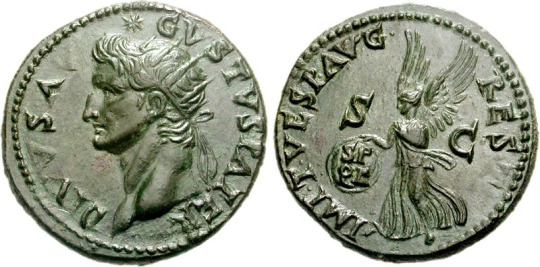
Divus Augustus under Titus (restitution issue that takes the design of that Tiberius Dupondius). Struck 80-81.

Divus Augustus As issued under Nerva (kind of a restitution issue, but not really) Struck 97-98. Eagle perched on thunderbolt on reverse.
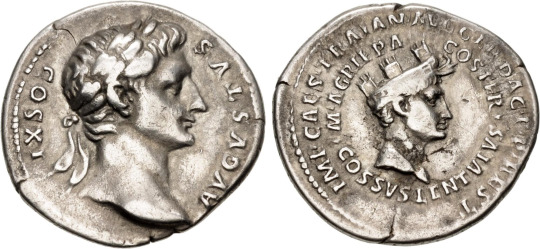
Under Trajan, another restoration issue of one of Augustus's denarii and technically not a Divus issue but I'm still putting here because I like it. Struck 107 or 112-113
Reverse depicts his bestie Agrippa

Cistophoric Tetradrachm struck under Hadrian, 128 (Augustus is literally just a beardless Hadrian here) Reverse depicts Hadrian holding some corn ears.

Skipping forward quite a bit, Divus Augustus Antoninianus issued under Trajan Decius as a part of his "Divus" series of coins. Reverse depicts a lit altar. Struck 249-251.
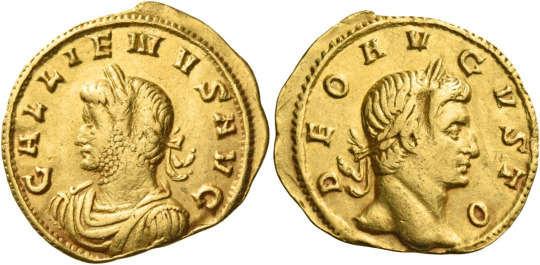
Deo Augusto issue, this one is really interesting as it is *theorized* that this was struck as a way to ask for aid from Augustus the god during Gallienus's disastrous reign. Struck 260-268.
#ancient coins#ancient rome#ancient art#ancient history#roman art#history#roman coin#roman coins#roman empire#roman emperor
78 notes
·
View notes
Text

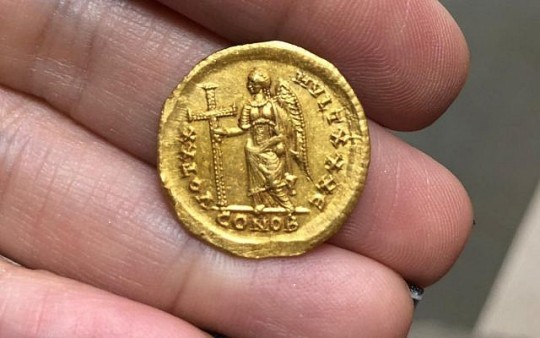
Gold coin from the reign of Emperor Thedosius II uncovered in Israel in 2019, Eastern Roman Empire, circa 401-450 AD
423 notes
·
View notes
Text

Sometimes you just have draw Nero
#emperor nero#ancient rome#roman empire#roman history#idk how to tag this#based on coins from 55 and 67
63 notes
·
View notes
Text
As the Ides of March approaches, I'd like to remind you that this coin exists.

Brutus issued this denarius to commemorate the assassination of Caesar. I love how the coin is like:
It is time to celebrate the #idesofmarch, guys! #stab #stab #hat
#the hat is a pileus which symbolizes liberty#but id like to think there was just some random hat on that ides of march coin#stab#hat#ancient rome#tagamemnon#brutus#cassius#gaius julius caesar#julius caesar#ides of march#the ides of march#roman history#pileus#ancient clothing#funny#roman coins#march 15#et tu brute
194 notes
·
View notes
Text

Dupondius of the Roman emperor Tiberius (r. 14-37 CE), minted in 34-35. On the obverse, the bust of Tiberius, crowned with laurel; Tiberius here styles himself DIVI AUG(USTI) F(ILIUS)="Son of the deified Augustus". On the reverse, a male portrait bust within a shield-ring, surrounded by the inscription CLEMENTIAE S(ENATUS) C(ONSULTO). This may be a reference to the shield voted to Augustus by the Senate in 27 BCE, which bore the inscribed virtues of virtus, clementia, iustitia, and pietas. Following the lead of Julius Caesar, Augustus and his successors stressed clementia as a characteristic trait of the emperor, who had it in his power to extend mercy to defeated enemies. In this case, there is a certain irony to the imagery, as Tiberius' last years were marked by many trials and condemnations for offenses against the imperial maiestas at the behest of informers.
#classics#tagamemnon#history#ancient history#Ancient Rome#Roman Empire#Roman history#Tiberius#art#art history#ancient art#Roman art#Ancient Roman art#Roman Imperial art#coins#ancient coins#Roman coins#Ancient Roman coins#dupondius#numismatics#ancient numismatics#Roman numismatics
99 notes
·
View notes
Text

Hoard of Roman gold coins discovered near Deopham, England, late 4th century AD
from The Norfolk Museums Collections
120 notes
·
View notes
Text

Discovery of Roman Buried Coins in Wales Declared Treasure
Two sets of coins found by metal detectors in Wales are actually Roman treasure, the Welsh Amgueddfa Cymru Museum announced in a news release.
The coins were found in Conwy, a small walled town in North Wales, in December 2018, the museum said. David Moss and Tom Taylor were using metal detectors when they found the first set of coins in a ceramic vessel. This hoard contained 2,733 coins, the museum said, including "silver denarii minted between 32 BC and AD 235," and antoniniani, or silver and copper-alloy coins, made between AD 215 and 270.
The second hoard contained 37 silver coins, minted between 32 BC and AD 221. Those coins were "scattered across a small area in the immediate vicinity of the larger hoard," according to the museum.
"We had only just started metal-detecting when we made these totally unexpected finds," said Moss in the release shared by the museum. "On the day of discovery … it was raining heavily, so I took a look at Tom and made my way across the field towards him to tell him to call it a day on the detecting, when all of a sudden, I accidentally clipped a deep object making a signal. It came as a huge surprise when I dug down and eventually revealed the top of the vessel that held the coins."
The men reported their finds to the Portable Antiquities Scheme in Wales. The coins were excavated and taken to the Amgueddfa Cymru Museum for "micro-excavation and identification" in the museum's conservation lab. Louise Mumford, the senior conservator of archaeology at the museum, said in the news release that the investigation found some of the coins in the large hoard had been "in bags made from extremely thin leather, traces of which remained." Mumford said the "surviving fragments" will "provide information about the type of leather used and how the bags were made" during that time period.
The coins were also scanned by a CT machine at the TWI Technology Center Wales. Ian Nicholson, a consultant engineer at the company, said that they used radiography to look at the coin hoard "without damaging it."

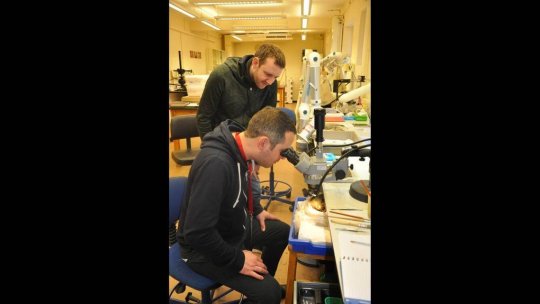
"We found the inspection challenge interesting and valuable when Amgueddfa Cymru — Museum Wales approached us — it was a nice change from inspecting aeroplane parts," Nicholson said. "Using our equipment, we were able to determine that there were coins at various locations in the bag. The coins were so densely packed in the centre of the pot that even our high radiation energies could not penetrate through the entire pot. Nevertheless, we could reveal some of the layout of the coins and confirm it wasn't only the top of the pot where coins had been cached."
The museum soon emptied the pot and found that the coins were mostly in chronological order, with the oldest coins "generally closer to the bottom" of the pot, while the newer coins were "found in the upper layers." The museum was able to estimate that the larger hoard was likely buried in 270 AD.
"The coins in this hoard seem to have been collected over a long period of time. Most appear to have been put in the pot during the reigns of Postumus (AD 260-269) and Victorinus (AD 269-271), but the two bags of silver coins seem to have been collected much earlier during the early decades of the third century AD," said Alastair Willis, the senior curator for Numismatics and the Welsh economy at the museum in the museum's news release.
Both sets of coins were found "close to the remains of a Roman building" that had been excavated in 2013. The building is believed to have been a temple, dating back to the third century, the museum said. The coins may have belonged to a soldier at a nearby fort, the museum suggested.
"The discovery of these hoards supports this suggestion," the museum said. "It is very likely that the hoards were deposited here because of the religious significance of the site, perhaps as votive offerings, or for safe keeping under the protection of the temple's deity.
By Kerry Been.
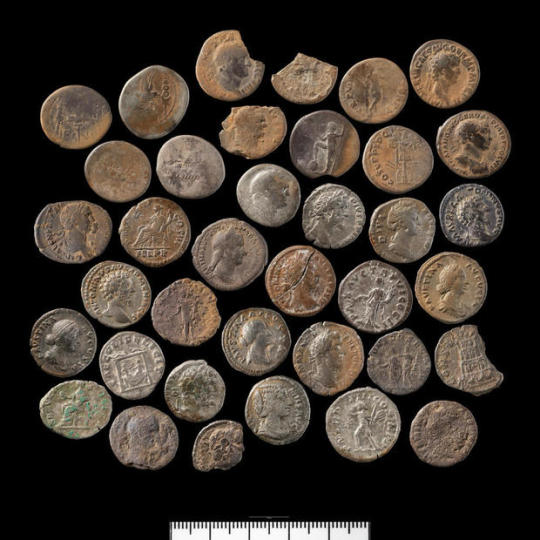
#Discovery of Roman Buried Coins in Wales Declared Treasure#coins#collectable coins#roman coins#metal detecting#ancient artifacts#archeology#archeolgst#history#history news#ancient history#ancient culture#ancient civilizations#roman history#roman empire#roman art
165 notes
·
View notes